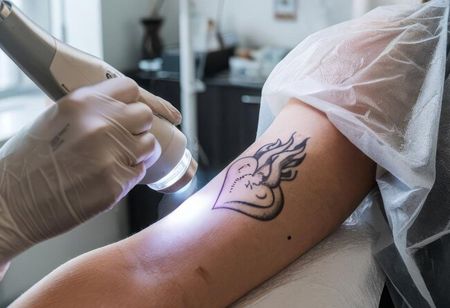
Tattoos can be a form of self-expression, but sometimes, people change their minds or have other reasons for wanting to remove them. If you're considering tattoo removal, dermabrasion is one option you might have heard about. In this step-by-step guide, we'll walk you through the process of dermabrasion tattoo removal and help you determine if it's the right choice for you.
What is Dermabrasion Tattoo Removal?
Dermabrasion is a surgical procedure that involves using a rapidly rotating device to sand down the top layers of skin. This process removes the tattoo ink along with the skin, leaving a smoother, ink-free surface.It's important to
Is Dermabrasion Right for You?
Before deciding on dermabrasion, it's crucial to consult with a qualified professional to determine if you're a good candidate. Factors such as skin type, tattoo size, location, and ink colors can all impact the effectiveness of the procedure. In some cases, laser tattoo removal or other methods may be more suitable.
Preparing for the Procedure
If you and your provider decide that dermabrasion is the best option, there are several steps you can take to prepare for the procedure:
1. Avoid sun exposure and tanning for at least two weeks before the treatment.
2. Stop smoking, as it can slow down the healing process.
3. Inform your provider of any medications or supplements you're taking, as some may need to be temporarily discontinued.
The Dermabrasion Process
On the day of the procedure, your skin will be cleaned and numbed with a local anesthetic. The provider will then use the dermabrasion device to carefully remove the top layers of skin in the tattooed area. The process can take anywhere from a few minutes to over an hour, depending on the size and complexity of the tattoo.
Aftercare and Recovery
After the procedure, your skin will be raw, swollen, and may ooze for a few days. Your provider will give you detailed instructions on how to care for the treated area, which may include:
4. Keeping the area clean and covered with a sterile dressing.
5. Applying antibiotic ointment to prevent infection.
6. Taking pain medication as prescribed.
7. Avoiding sun exposure and using sunscreen once the skin has healed.
The healing process can take several weeks, and it's essential to follow your provider's instructions closely to minimize the risk of complications and ensure the best possible results.
Potential Risks and Side Effects
As with any surgical procedure, dermabrasion tattoo removal comes with some risks and potential side effects, including:
8. Infection
9. Scarring
10. Changes in skin color or texture
11. Incomplete tattoo removal
It's important to discuss these risks with your provider before the procedure and to carefully weigh the potential benefits against the possible complications.
Finding a Qualified Provider
If you're considering dermabrasion tattoo removal, it's essential to choose a reputable, experienced provider. Look for a board-certified dermatologist or plastic surgeon who has extensive experience with the procedure. If you're in the Gold Coast, QLD area, research providers who offer professional Gold Coast QLD tattoo removal to ensure you receive the highest quality care.
In conclusion, dermabrasion tattoo removal can be an effective way to remove unwanted tattoos, but it's not the right choice for everyone. By understanding the process, potential risks, and importance of finding a qualified provider, you can make an informed decision about whether dermabrasion is the best option for you. Remember, tattoo removal is a personal choice, and it's essential to do what feels right for you and your skin.
We use cookies to ensure you get the best experience on our website. Read more...
Copyright © 2025 HomesIndiaMagazine. All Rights Reserved.